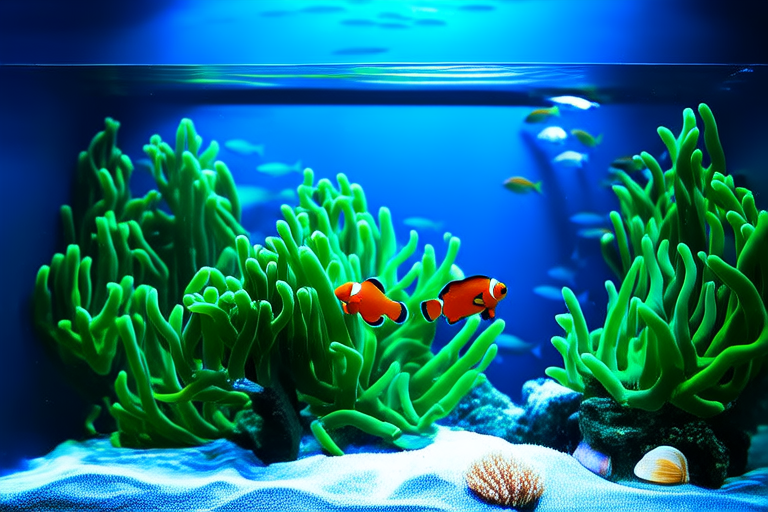How to Create a Perfect Habitat for Your Clownfish at Home
Clownfish are among the most popular choices for home aquariums due to their vibrant colors and fascinating behaviors. However, creating a perfect habitat for these fish requires careful planning and maintenance to ensure their health and happiness. This guide will walk you through the essential steps to set up a thriving environment for your clownfish, covering everything from aquarium setup to diet specifics.
Aquarium Setup
The first step in creating a suitable habitat for your clownfish is choosing an appropriate aquarium. Clownfish require a minimum tank size of 30 gallons, but larger tanks are better for their well-being. A larger tank allows for more swimming space and helps maintain water quality, which is crucial for the health of your fish.
When setting up the tank, ensure it has a secure lid to prevent your clownfish from jumping out. Also, consider adding a heater to keep the water temperature stable, as clownfish prefer warmer waters.
Water Parameters
Maintaining the correct water parameters is vital for the health of your clownfish. The ideal temperature range for clownfish is between 76°F and 82°F. Consistent temperatures within this range will help reduce stress and promote healthy growth.
Clownfish thrive in slightly acidic to neutral water with a pH level between 7.8 and 8.4. Regularly testing the water and making adjustments as needed is important to ensure optimal conditions for your fish.
Filtration Systems
Effective filtration is key to maintaining clean and healthy water for your clownfish. Choose a filtration system that can handle at least four times the volume of your tank per hour. Biological, mechanical, and chemical filtration components work together to remove waste, toxins, and excess nutrients from the water.
Biological filtration involves beneficial bacteria that convert harmful ammonia into less toxic compounds. Mechanical filtration removes debris and particulates, while chemical filtration helps eliminate dissolved organic compounds.
Appropriate Tank Mates
Choosing the right tank mates for your clownfish is crucial for their well-being. Clownfish are generally peaceful and can coexist with other non-aggressive species. However, it’s essential to research each potential tank mate to ensure compatibility. Avoid placing clownfish with overly aggressive or territorial fish.
Clownfish also have a symbiotic relationship with sea anemones in the wild, providing protection from predators. While not necessary in home aquariums, adding a small anemone or similar plant can offer additional hiding spots and enhance the overall aesthetic of your tank.
Diet Specifics
Clownfish are omnivorous, meaning they eat both plant-based and animal-based foods. In the wild, they feed on algae, zooplankton, and small invertebrates. In captivity, provide a balanced diet consisting of high-quality flake food, pellets, and occasional live or frozen foods like brine shrimp or mysis shrimp.
Feeding your clownfish once or twice daily is sufficient. Be cautious not to overfeed, as excess food can lead to poor water quality and health issues. Monitor their eating habits and adjust portion sizes accordingly.
Hiding Spots
Providing ample hiding spots is essential for the well-being of your clownfish. These areas serve as safe spaces where the fish can retreat when feeling threatened or stressed. Rocks, caves, and plants can be used to create these hiding spots. Ensure that the hiding spots are stable and won’t shift or collapse under the weight of the fish.
Clownfish also appreciate a varied landscape with different levels and depths. This mimics their natural environment and encourages exploration and exercise.
Tips for Beginners
Starting a new aquarium can be overwhelming, especially for beginners. Here are some tips to help you get started:
- Choose a reliable aquarium supplier and ask for advice on equipment and care routines.
- Start with a basic setup and gradually add more features as you gain experience.
- Be patient and give your clownfish time to acclimate to their new environment.
- Regularly monitor water parameters and make adjustments as needed.
Tips for Advanced Aquarists
For those with more experience, here are some advanced tips to further enhance your clownfish habitat:
- Consider setting up a reef tank with live rock and corals to create a more complex ecosystem.
- Experiment with different lighting schedules and intensities to encourage natural behaviors.
- Monitor the nitrogen cycle closely and adjust filtration systems as needed.
- Keep detailed records of water parameters, feeding schedules, and any changes in fish behavior.
The Importance of a Stable Environment
Creating a stable environment is paramount for the health and behavior of your clownfish. Stress can weaken their immune systems, making them more susceptible to diseases. By maintaining consistent water parameters, providing adequate hiding spots, and selecting compatible tank mates, you can significantly improve the chances of your clownfish living a long and healthy life.
Additionally, a stable environment promotes natural behaviors such as breeding and exploring. Clownfish are social creatures and benefit from having companions, whether they are other clownfish or compatible tank mates.
Conclusion
Creating a perfect habitat for your clownfish requires attention to detail and ongoing care. By following the guidelines outlined in this article, you can provide a thriving environment that supports the health and happiness of your fish. Whether you’re a beginner or an experienced aquarist, the joy of watching your clownfish thrive in their new home is truly rewarding.
